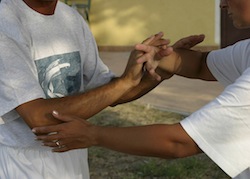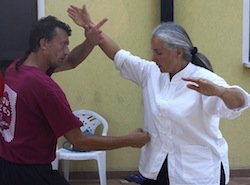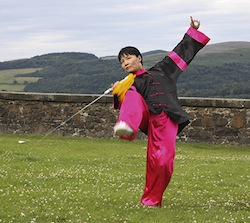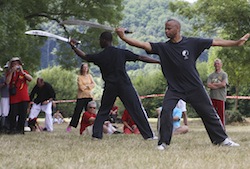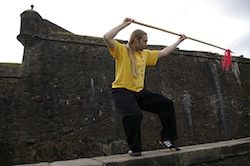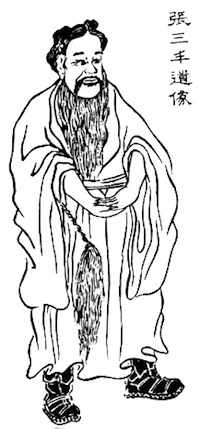What is Tai Chi Chuan (Taijiquan)?
Tai Chi Chuan is a Chinese exercise system enjoyed by millions of people across the world. Originally developed as a highly effective martial art it is now practised by people of all ages, for a wide range of reasons including martial art, a gentle exercise for those with physical limitations, a body/mind system with meditative qualities and a method of self-cultivation.
Meaning of ‘Tai Chi Chuan’
Yin and Yang
What Happens in a Tai Chi Class?
The Tai Chi Hand Form
Tai Chi Partner-work
Tai Chi Weapon Forms
13 Postures
Tai Chi Styles
Tai Chi’s Early History
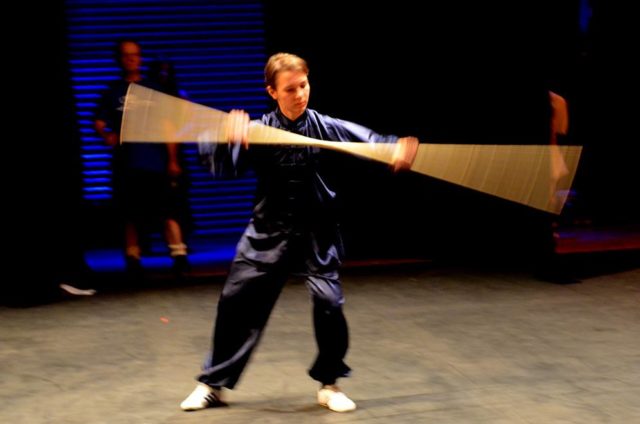
Meaning of ‘Tai Chi Chuan’
The words “Tai Chi Chuan” (also written as Taijiquan) illustrate the concepts at the heart of the system and they are translated as “Supreme Ultimate Fist”.
Tai Chi (Taiji) is the symbol which is used to depict the opposite, yet complementary forces of Yin & Yang.
Chuan (Quan) translates as ‘Fist’ or ‘Boxing’, therefor Tai Chi Chuan is a martial art system which operates on the practical application of the philosophical Daoist concept of Tai Chi. A principle centring on the understanding of the on-going changes in the relationship of the qualities of Yin and Yang is an integral component of many Chinese disciplines including Traditional Chinese Medicine, Chinese Geomancy (Feng Shui), Divination (I Ching) and Astrology.
The Tai Chi symbol combines black and white fish-like shapes within a circle.
The empty circle depicts the notion of Wu Chi – emptiness or nothingness, the starting point before creation. Tai Chi practitioners are encouraged to stand quietly before beginning the ‘Form’ or exercise routine, to ‘empty’ their minds and develop a deeper connection to the skies above and the ground below, “Heaven” and “Earth” with man being connected between both.
Audio file “pronunciation”
Yin and Yang
After creation comes the interaction of the two energies of Yin and Yang and in the Tai Chi symbol they are depicted in equal quantities or in balance. This symbol illustrates the desire of working to attain balance, primarily by developing a sense of where there is imbalance or disharmony. These two qualities can depict all aspects under creation and here are a few common examples.
If we look at some of these examples, considering the gradual transitions, such as the rising and setting of the sun (Yang) , the appearance and disappearance of the moon (Yin), as day (Yang) changes to night (Yin), and the shifting of the seasons from summer (Yang), through autumn, winter (Yin), then to the new growth of spring.
In the art of Tai Chi Chuan we also learn to experience, often on a very deep level, the on-going changes from Yin to Yang and Yang to Yin.
In stepping from one posture to the next we gently place our heel on the ground, testing to see if we have a firm place to stand, then slowly and gradually transfer our weight, whilst experiencing the emptying and filling from one leg to the other.
Our lower body is deeply connected to the ground or earth (Yin) whilst our upper body remains light, open and flexible, reaching upwards towards the heavens (Yang).
In the martial application we allow our opponent to deliver the full force (Yang) of his attack whilst gently touching or ‘adhering’ to it as it moves and then allowing our other hand or move loosely, from the turning of the body, to connect with the opponent of his open or empty side.
What Happens in a Tai Chi Class?
There are many ways in which tai chi is taught and practised, from the various key styles and their many offshoots, to the numerous aspects such as solo routine or ‘Form’, partner exercises, which vary from gentle ‘sensing’ work, pushing-hands, partner drills and full-contact martial applications. In our instructors’ database we allow space for teachers to include details of the various aspects they teach and here are a few guidelines of what can be on offer.
The Beginning
In most exercise classes some work is usually done to warm-up the body prior to a vigorous workout. In tai chi classes we’re primarily concerned with moving slowly and sensitively whilst developing a deep awareness of how our body feels, on a number of levels. This being the case there’s no need to warm up the body first. During the work of tai chi we learn to relax our bodies by loosening held tensions through a range of movements that are dominated by turning from our waist and pelvic area and /or shifting our weight from foot to foot whilst allowing the arms to swing from this motion of the body, like a pendulum. As the arms loosen and lighten they move freely, as natural extensions of our body.
Tai Chi Breath-work
During the practice of tai chi we pay attention to our breathing, allowing it to come from deeper in our bellies rather than our chests or upper bodies, which often occurs when we are in situations of stress, tension or conflict. Before beginning any movements students are often encouraged to spend some time standing quietly whilst ‘listening’ to their breathing and quietening the mind. There are many disciplines working with this principle as a tool for self-awareness and mindfulness.
Relaxation
An integral aspect of tai chi is to relax both the body and mind. Through ‘listening’ to our breathing, loosening held tensions in the body and stilling the mind we learn to relax the integrated whole. Relaxation is best achieved when one develops a real sense of our on-going tensions and stresses, both physical and mental, once this is realised we can slowly and gradually take steps to improve things. With tai chi, by moving slowly, with sensitivity and awareness, we get closer to realising all these tensions and let them release from our bodies and minds.
The Tai Chi Hand Form
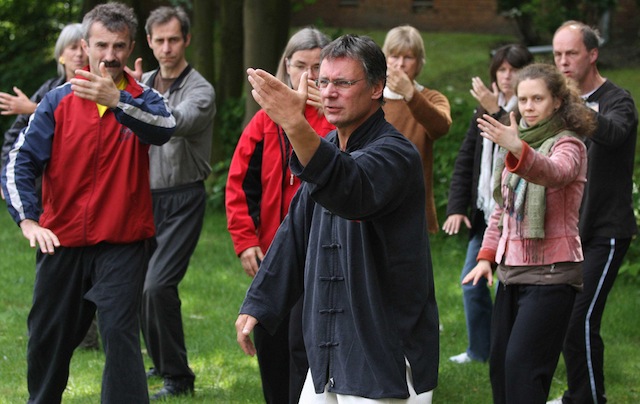
The slow, continuous series of flowing movements seen in any Chinese park in the early mornings are often the tai chi hand form. This is a specifically choreographed series of movements know as the ‘Form’. During the process of performing these routines we work with learning to develop a connection to the ground, through slowly transferring the weight from one foot to the other, relax the muscle groups and attain a good, upright posture. Through time we get closer to understanding the ergonomics of the body, how to move fluently, efficiently and effectively in a coordinated fluid manner.
Tai Chi Partner-work
As we become more accustomed to the choreography of the ‘Form’ working with a partner allows us a safely structure place to test if the principles of relaxation, fluidity and effectiveness of movement are being learned. Partner-work can range from soft, gentle sensing exercises, light pressing or pushing to develop responsiveness to full-contact fighting. The principles however are the same. When a force comes towards us, we learn to move with, rather than against it. See also #MartialMonday!
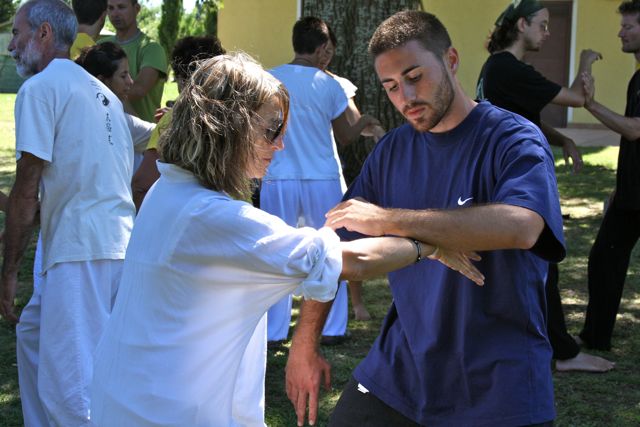
Push Hands
Push hands is a training exercise where one partner places his or her palm against the wrist of the other and proceeds to press towards their centre. Pushes should be executed only when one has a real sense of contact to the partner’s centre rather than just placing one’s hands on the surface of the others wrist and pushing indiscriminately, with no real sense of connection.
Single Push Hands
Usually one would start off with ‘Single-Hand Pushing’ where only one hand is in contact with the partner. The person being pushed should work towards moving only as much, or as little as is necessary, relative to the pushing of the other. Although the exercise is referred to as “Push Hands” the hands are merely the point of contact and the push should result from the whole body moving towards the partner’s centre, whilst the weight transfers forward.
Double Push Hands
In Two-Hand pushing the contact is made with one hand on he partner’s wrist and the other hand of the partner’s elbow joint. (Being in contact with two adjacent joints creates the opportunity to control your partner.) Then the push is made, again towards the partner’s centre, using a whole body connection. When you are being pushed in this way the object would be again to move back or around, in relationship to the push and turning the waist to allow your partner’s push to be ‘neutralised’. Once again the objective is to not block or impede your partner’s push but to allow them to push as much as they want, whilst taking evading action, creating the potential for them to over-push and unbalance themselves.
Free-Pushing
In Free-Pushing the objectives are the same in that one tries to find the partner’s centre and allow them to come out of it and lose their balance. Here the places for pushing are not restricted to the hands and arms but any part of the body excepting the head or, of course, the area around the genitals.
In all of these partner exercises we learn to increase our sensitivity, timing, awareness, balance, structure, focus and intent. By pushing, and being pushed simultaneously we are continually experiencing the changes from yin (passive, receptive soft) to yang (active, outward and forceful) whilst maintaining our central equilibrium.
San Shou
San Shou is free-sparring where free-flow, full-contact fighting takes place. Again the same principles apply as all other partner-work, in that we try to work to avoid blocking attacks, or actively pushing our opponent away, as we move according to their force, avoiding and moving around them, engaging in their flow and direction and returning our force as they are nuetralised. In some cases the term ‘San Shou’ is often applied to specifically structured, choreographed fight routines, or partner ‘forms’ however this is an inaccurate adoption of the terminology.
Da Lui
Da Lui is a partner routine, with clearly defined steps, postures and sequences that allow the ‘players’ to exercise or train the essential principles of tai chi within a particular framework.
Tai Chi Weapon Forms
There are a number of weapon forms practised in tai chi some of which were traditionally used and others that have been adopted, in some styles, to increase the range of training skills. Initially there were four classic weapons used in tai chi: sword, sabre, spear and staff. Whilst we must understand that there is little use for these various as weapons as implements of combat these days, the training with such weapons can enhance the practitioner’s understanding of the tai chi principles.
Tai Chi Sword or ‘Jian’
The tai chi sword is considered by many to be the weapon of gentlemen. It is used for piercing or slicing rather than chopping or hacking and, as such, requires a greater use of precision, delicacy and subtleness. The double-sided, flat-bladed instrument is sharp on both sides, coming to a point at the tip. The optimum size for a tai chi sword is that the point should reach the tip of the ear when held in the hand, flat against the side of the body, facing upwards.
Practising the sword form helps to develop focus, softness, fluidity, balance and ‘rooting.’
Tai Chi Sabre or ‘Dao’
The tai chi sabre, also referred to as broadsword, is used for chopping or hacking through the opponents and, as such it requires speed, precision and power. The flat-bladed instrument is sharp and curved on one edge and flat and blunt on the other. The larger, flat blade is used to block attacks to the body whilst the sharp edge is clearly for cutting or chopping. The length of the weapon should allow the point to reach the top of the shoulder when it is grasped in the hand, the flat edge leaning against the side of the arm.
Practising the sabre form develops focus, fluidity, speed, force and martial intent.
The tai chi spear is a long wooden pole, approximately 3 metres long, with a metal point at its tip. The spear is used for piercing attacks, blocking strikes and moving around oncoming lunges.
The spear develops, power, speed, intention, focus and flexibility.
Tai Chi’s Early History
Much of what has come to be accepted as the history of tai chi is steeped in legend, beginning with that of Zhang San Feng, an ex-government official who took himself off to the holy Daoist mountain, Wudang Shan, to prepare himself for the next life, by way of meditation and contemplation. During a meditation session he went into a trance where he had a vision of a fight between a snake and a crane. When the snake darted up to strike the crane the crane reared upwards and backwards to avoid his attack. The crane countered by pecking downwards at which point the snake slithered just out of reach. The fight went on for some time with no injury or damage to either creature. The images of birds and snake are prevalent in many cultures as symbols of male and female, and given the nature of tai chi, this story is no doubt allegorical. There are also indications that Zhang may have studied Shaolin boxing and other martial arts beforehand. Because of this dream, and his previous martial experiences he subsequently developed a series of movements, which was the genesis for what eventually became tai chi chuan, applying the principles of Tai Chi (the understanding of the continual changes from Yin to Yang and vice-versa) along with the natural, free-flowing movements of animals.
13 Postures
Chang San Feng’s original sequence of movements was said to have consisted of 13 postures. The number 13 was based on the combination of the Five Elements and the Eight Powers, Gates or Techniques.
The Five Elements
The Five Elements: Fire, Water, Wood, Earth and Metal relate to the following energies and positions in the Tai Chi Form.
Chin advance North Water
Tui retreat South Fire
Ku look left West Metal
Pan look right East Wood
Ting centre Centre Earth
The Eight Energies or ‘Jin’
Ward-Off or ‘Peng’
This energy has expansive opening buoyancy similar to after you pushing into a large ball you will soon experience its returning force.
Roll-Back or ‘Lu’
This is a yielding, receptive energy where a force is absorbed into a void.
Press or ‘Ji’
Here you make contact to your opponent through the hands, shoulder, arms or back, connecting to them and then transferring power through that connection my pressing into and through it.
Push or ‘An’
Here the hand, arm or shoulder is placed against the opponent’s body, whilst one establishes a connection from the back foot, through the point of contact and through the opponent’s body, disturbing his point of balance.
Pull Down or ‘Cai’
This is a like a plucking, hooking motion, allowing the force of come in and connecting to the direction with a pulling in motion.
Split or ‘Lie’
This technique would be applied by stepping one foot behind the opponent and connecting the forearm to their chest and turning from the waist and pelvis back into the opponent, trapping him with the leg and causing him to fall backwards, in the technique of ‘Diagonal Flying’.
Elbow or ‘Zhou’
‘Elbow-Stroke’ should be applied with a loose, relaxed arm and turning from the waist and pelvis. It has a quick, releasing action, stemming from the central axis of the body to the point of the elbow.
Shoulder or ‘Kao’
‘Shoulder-Stroke’ is applied by stepping in between the opponent’s legs, connecting your shoulder against their chest, and then transferring your weight to the forward leg, whilst maintaining this connection.
Tai Chi Styles
Whilst it is widely regarded that the genesis of what ultimately became tai chi chuan originated in Wudang Mountains, the first, original style of tai chi chuan originated in Chenjiagou Village, in Henan Province, in the 17th century by Chen Wangting.
Chen Style Tai Chi Chuan
Chen Wangting (1600-1680) was considered to be an educated gentleman who was also adept in martial arts. He was ‘Commander of the Garrison Force of Wenxian County in 1641 when he defeated bandits in Shangdong. When the Ming Dynasty was overthrown in 1644 he returned to his homeland in Chenjiagou to lay low. During this time of seclusion he worked to develop tai chi chuan with the following characteristics:
- Integrating breathing techniques with traditional martial art skills.
- Integrating Wushu techniques with the theory and principles of Traditional Chinese Medicine.
- Combining hand-to-hand contact martial techniques with that of sensitivity and ‘listening’.
- Creating Spear combat forms based on tai chi principles.
- Creating the theoretical aspects of tai chi chuan in relationship to the martial art.
Since its inception by Chen Wangting tai chi chuan has been handed down through the generations and is now widely known as a family tradition as a result of continued development by the following family members:
Chen Changxing (1771 – 1853)
Chen Youben
Chen Qingping
Chen Xin
Chen Zhopei
Chen Fake
Chen Xiaowang
Chen Zhenglei
Learn more about Chen Style Taijiquan
Yang Style Tai Chi Chuan
Yang Luchan (1799-1872) was a native on Yongnian County where he worked in a drugstore operated by Chen Dehu, (and owned by the Wu Family) a native of Chenjiagou. As Yang was a diligent, honest worker of good character Chen Dehu brought him to Chenjiagou, to become a disciple of Chen Changxing, whom he trained with for seven years. Yang went on to Beijing where he defeated many martial arts masters and became widely known as Yang the Invincible. He ultimately went on to train the Imperial Guard and many eminent figures in tai chi chuan, which caused him to adapt and shorten the previously demanding routines into more accessible forms, which could be learned quicker for those with less time to train intensely.
The Yang Style was developed further by subsequent generations of the Yang family, establishing it too as a family style of tai chi chuan. They included: Yang Jianhou, Yang Chenfu (1883-1936),
Wu (Hao) Style Tai Chi Chuan
Wu Yuxiang (1812-1880), also a native of Yongnian County, had trained in Wushu and subsequently learned Chen Style tai chi from Yang Luchan and later went to Chenjiagou to train with Chen Changxing. As he was by then getting older Cheng Changxing introduced Wu to Chen Qingping.
Wu subsequently passed his skills to his nephew, Li Yi Yu (1832–1892) who in turn taught Hao Wei Zhen (1849-1920). After three generations (Hao Yeuru (1877-1935), his son Hao Shao Ru (1908-1983) the Hao Style became recognised as one of the five major tradional styles of tai chi chuan.
The Wu Style is characterised by tighter, compact, soft, flexible movements.
Wu Style Tai Chi Chuan
Wu Jiangquan (1870–1942) learned tai chi from his father, Quan You learned Large Frame Tai Chi Form from Yang Luchan and then the Small Frame Form from Luchan’s son, Yang Jianhou. Wu Jianquan also trained intensively with Yang Luchan’s grandson, Yang Chenfu (1883-1936). In 1932 Wu moved from Beijing to Shanghai where the Wu Style tai chi chuan became hugely popular, spreading on to Hong Kong and southern China.
The Wu Style tai chi chuan lineage continued through his daughter, Wu Ying Hua (1907-1996) and her husband Ma Yeuhliang (1901-1998) and their son Ma Jiang Bao (1941-).
This Wu Style was also characterised by soft, compact movements.
Sun Style Tai Chi Chuan
Sun Lutang (1860–1930) of Wanxian, Hebei Province was a famous Master of Xingquan and Baguaquan in Beijing when he learned tai chi chuan from Hao Wei Zhen. He brought elements of the three disciplines together to create his Sun Style Tai Chi Chuan
Other Tai Chi Chuan Variations
Cheng Style Tai Chi Chuan
Cheng Man Ch’ing (1902-1975) studied Yang Style Tai Chi with the founder’s grandson, Yang Chengfu (1883-1936) for six years. Cheng was a unique figure in tai chi in that he came to tai chi primarily for health reasons, rather than martial training. When he was in his 20’s he contracted tuberculosis and took up tai chi training to help improve his lung function. He was a highly educated man who became known as a Master of Five Excellences: Traditional Chinese Medicine, Poetry, Calligraphy, Painting and Tai Chi Chuan.
Cheng helped write Yang Chenfu’s book Essence and Applications of Tai Chi Chuan and in 1949 moved to Taiwan where he taught Madame Chiang Kai-shek tai chi and, in turn, shortened the Long Yang Form to the shorter 37-Step Form to allow Chiang Kai-shek’s army to learn it quicker than the considerable time required to master a long form.
Cheng’s form took 10 minutes to perform, was less expansive than the traditional Yang Form and emphasised relaxed, soft hands. He was the first practitioner to bring tai chi chuan to the west having moved to San Francisco and subsequently New York (1964) where he founded his Shr Jung Tai Chi School.
See also our Professor Cheng Man Ching Series!
Dong (Tung) Style Tai Chi
Dong Yingjie (1898-1961) was a top student of Yang Chenfu (1883-1936) who passed his knowledge of tai chi on to his son, Dong Hu Ling who, in turn, trained his sons Dong Kai Ying and Dong Zhen Chen
42-Step Competition Tai Chi Chuan
Prior to 1988 tai chi chuan, being passed down a few generations of the Five Traditional Styles had many variations and interpretations from these original styles. In 1990 China played host to the 11th Asian Games where the announced the 42-Step Competition Routine. Its principal creator, Li Deyin worked with a team of tai chi professionals to create a new combination 42-step form, which contained uniform elements to which judges could clearly evaluate. The Form contained the ‘silk-reeling’ elements of Chen Style, the graceful, strength of Yang Style, the subtleties of Wu Style and flexibility of Sun Style.
Recommended reading on Tai Chi Chuan (Taijiquan)
Ways to learn Qigong and Taijiquan
Part 1: Weekly courses
Part 2: DVDs, videos and online-programmes
Part 3: Workshops – Weekend courses
Part 4: Workshops – Exchange meetings
Free Tai Chi at home online course
The first two videos will cover the basic posture and the position of the feet (bow stance), followed by videos for the single movements. For those interested in the intention behind the movements (or the martial application training), we will add the relevant episodes of our #martialmonday project.
- Basic posture
- Tai Chi 8 Movements – Posture 1 – Beginning
- Tai Chi 8 Movements – Posture 2 – Ward Off Left
- Tai Chi Bow Stance
- Tai Chi 8 Movements – Posture 3 – Ward Off Right
- Tai Chi 8 Movements – Posture 4 – Pull
- Tai Chi 8 Movements – Posture 5 – Press
- Tai Chi 8 Movements – Posture 6 – Push
- Tai Chi 8 Movements – Posture 7 – Open Up
- Tai Chi 8 Movements – Posture 8 – Crossing Hands
Tai Chi Aspects
Tai Chi Aspects are single images and concepts on which one may concentrate while doing the form. They are tools for form refinement and are meant to encourage discovering, trying out of alternatives and learning.
The videos on Tai Chi Aspects have been developed in the course of our “Tai Chi at home” project. All aspects are shortly presented by Nils Klug and and then demonstrated by means of our 8 movement, which has been specially created for the project.

10 reasons to start Tai Chi Modern society with its increased pace and consumerism makes multiple demands on every individual: Do well in your career while caring for your near and dear, but do not forget your self-development goals! Trivial questions as well as life choices fill our heads: How can I cope with the pressure of deadlines? What is best to do next? Am I happy with my life? – Possible life projects and commitments seem to linger at every corner. Living in the digital age, our brain is overflowing with impressions and ideas, positive as well as negative…
Your Tai Chi clothing should be comfortable and your shoes should be supportive, but light. Your Tai Chi clothes should allow all kinds of arm and leg movements. Wide – not too wide – and stretchy is to be preferred over tight and stiff.
Tai Chi – Learning and Practising Tai Chi Chuan is a Half-open Door art. It has ceased to be an imperial, or aristocratic, or clan treasure hidden from outsiders, so it is no longer a Closed Door art. However, particularly for westerners, the door into Tai Chi Chuan is not wide open. Without the grounding in ideas, learnt “at your mother’s knee”, that a Chinese child soaks up, we can look at the players and still miss details.
How long and how often should I practise Taijiquan or Qigong? Not unlike Japanese culture, the Chinese ideal for physical exercises is hard work. The Chinese word for that is “gong” (功). It is used in “Qigong” – working with the Qi, i.e. cultivating life energy – as well as in “gongfu” – referring to skills which are developed in a long work process. Gongfu applies to both martial skills and skills of a craftsman or an artist, in fact to all activities which need much effort to be mastered.
How to find a good Qigong or Tai Chi teacher? – A small guide The title of a “teacher” or even a “master” or a “grandmaster” is not protected. Anyone can call him/herself “Qigong Master” or “Tai Chi Master” and open a school. So how to sift out the good ones?
Prepare your Tai Chi / Qigong trial lesson Tips – Prepare your trial lesson- A good preparation is half of the pie! For your way to the Tai Chi / Qigong trial lesson, we have assembled a few hints and some questions for you to chew on.
Taijiquan Training Some illnesses or diseases may not respond to the more superficial exercises of a wellness-style qigong or Taijiquan. Examples are old injuries which developed into a body changing posture due to the patient’s try to avoid pain or shortened sinews after surgery or immobilisation of parts of the body after a bone fracture. But also sitting occupations in the workplace or computer work can evoke back pain, neck pain, let alone the so-called “mouse hand” or “tennis elbow”. – You “train” to assume these kinds of wrong seated “work postures”…
Interviews with the Masters View a series of interviews with Masters from various tai chi styles.
Tai Chi Styles An introduction to the differing styles and approaches to Tai Chi Chuan.
Taijiquan Classics Here you can find a translation of the Taijiquan Classics. Dr. Tao Ping Siang translated the Taijiquan Classics into English for his Western students. The first book, including the Chinese original texts, was published in Taiwan 1966. I had the great honour to publish that book for my second teacher in German. The book „Unter der Oberfläche der Klassiker des Tai Ji Quan“ was published in 2000 and is now out of print/sold out…
Interview with James Lau K King Master James Lau K King (刘恭庆) from Miri, Malaysia was so kind to give a in depth interview on his personal and Tai Chi life. He talks about his childhood how he met his teacher GM Huang Sheng Shyan in 1977…
Faye Yip Interview Faye Yip is a Qigong and Taijiquan teacher based in the UK. Together with her husband, Tary Yip, she initiated the British Health Qigong Association (BHQA), promoting Health Qigong and Taijiquan in the UK. The BHQA is affiliated with the International Health Qigong Association, whose origin lies in the People’s Republic of China, the Chinese Health Qigong Association being their biggest branch. With high-ranking contacts to the official Taijiquan community and family ties back in China on the one hand, and her own family and teaching life in the UK on the other hand, Faye walks between the worlds…
The little book of Tai Ji Quan This article is an excerpt from ‘The Little Book of Tai Ji Quan’ by Dr Ben Morris. The pursuits and achievements of the past masters, and of their written work; what use is all of this? It was not written to describe some esoteric babble, nor was it designed to confuse and torment those practitioners who were to come with impossible goals and aspirations…
Feeling the Tai Chi Form It is quite a difficult task to convey in words or images feelings and subtle movement. This must by its nature, be a very personal account of how one feels when moving through the various postures of a tai chi form. My teacher said to me” Tai Chi Chuan is not a technical exercise”. “You must feel your form and be aware of each of the movements as you pass through them”. Over the years this has meant a great deal to me.
Tai Chi Spirit Some time ago, a student asked me “when do you get good at this?” This was someone with quite a bit of experience. My answer was, ”Practising is more important than being good at it”.
Taiji Leads to the Esoteric Both Taiji and esoteric study have a deep effect on our actions, our character and our other pursuits in life. Taiji practice disciplines the body for mental control and presents opportunities to experience kinesthetically a “Pure Presence.” Taiji’s slow, precise movements are perhaps more conducive to meditation for a westerner than sitting meditation, and the practice of Taiji may indirectly lead people to esoteric study who are otherwise more oriented towards the physical than the mental disciplines…
The Eight Gates of Tai Chi Chuan In the work of tai chi chuan there are certain key aspects or qualities that should be trained to allow a fuller understanding of how the art works both as a health exercises and, more essentially, as an effective martial art.
Five Faces of Tai Chi When people only know of or focus on one aspect of a system, they commonly mistakenly think they are able to discern all there is to it. Tai chi chuan and the related art of ba gua chang are many things under one roof. Traditionally both have five faces, some of which are more popular, well-known and more widely available than others. Each layer or face takes you closer toward the internal martial art’s deeper possibilities and full potential.
Tai Chi – What’s to Like? In these pages various teachers from around Europe give us a few lines on why they like tai chi.
Chinese Martial Arts Terminology Taijiquan, T’ai Chi Ch’uan, Taiji Quan or Grand Ultimate Boxing? Learn more about on differing conventions on how words are written and spelt.
Tai Chi T-Shirts designs from around Europe. There are many ways in which we can present our schools or approaches to the art but the ubiquitous T-Shirt is by far the most popular. We’d like to share design concepts and welcome your contribution to this area – why not send us an image of your T-Shirt.
Oh, Why Is It So Difficult? On the Difficulty of Lasting Change in the Practice of Taiji: Serious progress in the practice of taiji often requires far-reaching changes that can involve various levels of training. Christine Schneider investigates the question of why such changes are so hard to achieve and explains, on the basis of the teachings of Patrick Kelly, that a deeper level of consciousness is required for essential changes.
How wrong can you be? 10 Common Errors in Tai Chi!
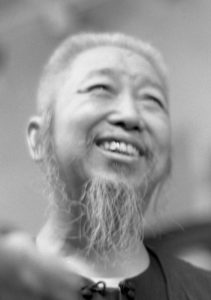
Professor Cheng Man Ching Series
Cheng Man Ching – A short biography
Cheng Man Ching was also named the “Master of Five Excellences“. He was one of the first who taught Taijiquan in the West and his Taijiquan style is spread all over the world. Here you will find many articles about his teaching and how it is taught by his his students.
Cheng Man Ching Photographs
Cheng Man Ching’s way of teaching (4): On being a master Cheng Man Ching’s teaching was marked by underlining sameness and diversity at the expense of hierarchy and difference. This approach formed the basis of his unique way of bridging the cultural gap between East and West.
Cheng Man Ching’s way of teaching (3): On meditation Our idea of meditation is mainly influenced by two aspects, the visual and the practical aspect. The mind’s uniform picture of a meditating person is someone sitting still in a peaceful environment, in a monastery or on a mountain.
Cheng Man Ching’s way of teaching (2): The Dantian The discussion about the nature of the Dantian is old and it remains unresolved until today: Is the Dantian a bodily, material reality or an ideal concept of Traditional Chinese Medicine to explain certain psychosomatic correlations? The debate cannot simply be described as a conflict between East and West or between Tradition and Modernity.
Cheng Man Ching’s way of teaching (1): “I am not a guru.” Cheng Man Ching, student of Yang Chengfu, came to New York in the 60s, at first teaching Taijiquan in the Chinese community, later also teaching Westerners. Being a university professor from a family of scholars and deeply rooted in traditional Chinese culture, he was confronted with flower children searching for a guru.
Cheng Man Ching on the dao of Taijiquan – a poem Cheng Man Ching is portrayed by his students as an example of total dedication and commitment to the Chinese Arts, especially concerning Taijiquan.
Self-massage as taught by Prof. Cheng Man Ching Cheng Man Ching was known as a master of the five excellences. As a teacher, he taught calligraphy and Traditional Chinese Medicine as well as Taijiquan, Push Hands and sword fencing. Advocating Taijiquan as a method of self-cultivation and health-preservation, he also used to teach his Taijiquan students aspects of other Chinese arts.
Cheng Man Ching Yang style Professor Cheng Man Ching (1900 – 1975) learned Tai Chi Chuan in the tradition of the classical Yang style from Yang Chengfu in Shanghai. There he was close friends with Ma Yueliang, the representative figure of the new Wu style. After the death of his teacher Yang Chengfu in 1935, and with the permission of Chen Weiming, a student of Yang Chengfu, and his father Yang Jianhou, Cheng Man Ching developed the so-called “short form”, in which 37 positions are counted, from the the well-known long form with 85 or 108 positions, depending on how they are counted.
Ken van Sickle on Cheng Man Ching In this 5-part interview series, Ken van Sickle, photographer, Tai Chi Master and student of Cheng Man Ching in New York, talks about studying with Cheng Man Ching and his desire to capture Cheng Man Ching’s spirit of learning and developing in the movie “The Professor – Tai Chi’s Journey West”. Further points are the sense and non-sense of lineages, the crucial question of “what to get from a master?”, Tai Chi goals and finally the meaning of Tai Chi weapon training, especially concerning the sword as instrument of the Dao…
My Father by Katy Cheng My father was born in the last century, well imbued with the traditional Chinese culture. But he was not weighed down by the old. He was open-minded, a tireless teacher, creating new ideas with full enthusiasm and keeping doggedly his principles in those fashion-filled times. After inheriting the past, he was a forerunner for the present, without being contaminated by the new heresies.
A Grandfather’s Heritage – Professor Cheng: Professor Cheng’s essays and commentaries on the Chinese classics give us rare insight into the mind of a …
Interview with direct Cheng Man Ching students William CC Chen, Benjamin Lo, Hsu Yee Chung and Hung Ping Chu answered question on Cheng Man Ching Tai Chi.
The Professor: Tai Chi’s Journey West – A Review The documentary The Professor: Tai Chi’s Journey West by Barry Strugatz/Ken van Sickle can be warmly recommended. Both Barry Strugatz and Ken van Sickle are themselves practitioners of Taijiquan, the latter being a master Student of Cheng Man Ching himself – their documentary view is thus one from the inside…
The title of “Master” in the Tai Chi lineage Back in (historic) China, the terms used to formally address one’s Taijiquan teacher in the proper way depended on the actual student-teacher relationship. While the Chinese terms differ widely, in English language the use of “Master” became widely accepted. Being formally addressed as a Master by one’s student has been and still is a question of courtesy and respect for many practitioners and teachers, although some schools in the European Cheng Man Ching tradition have dispensed completely with these formal honorary titles…
Cheng Man Ching’s students on mastery Cheng Man Ching’s direct students – the “second generation” if one sees Cheng Man Ching’s influence as determining a new approach – seem to follow this new tradition while continuing to adapt further to modernity…
Grandmasters, Big Sisters and Elder Brothers As Taijiquan in the Cheng Man Ching tradition has gone beyond the traditional system of Baishi and formal acceptance into the “family” or the monastic community as a Tudi or disciple back in the 1960s, the honorable naming of elder teachers and students follows a mixed system. One logical line goes from Master to Grandmaster to Greatgrandmaster. These titles capture the direct (and historical) connection between the student, the teacher and the teacher’s teacher. They thereby depict an aspect of teaching which in traditional lines is referred to as “line of transmission” or…
Author: Ronnie Robinson
Images: Ronnie Robinson



